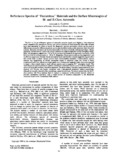| dc.contributor.author | Cloutis, Edward A. | |
| dc.contributor.author | Gaffey, Michael J. | |
| dc.contributor.author | Smith, Dorian G.W. | |
| dc.contributor.author | St. J. Lambert, Richard | |
| dc.date.accessioned | 2018-03-07T16:29:08Z | |
| dc.date.available | 2018-03-07T16:29:08Z | |
| dc.date.issued | 1990-01-10 | |
| dc.identifier.citation | Cloutis, E. A., M. J. Gaffey, D. G. W. Smith, and R. St J. Lambert. "Reflectance spectra of "featureless" materials and the surface mineralogies of M- and E-class asteroids." Journal of Geophysical Research 95 (1990): 281-294. DOI: 10.1029/JB095iB01p00281. | en_US |
| dc.identifier.issn | 0148-0227 | |
| dc.identifier.uri | http://hdl.handle.net/10680/1399 | |
| dc.description.abstract | The 0.3- to 2.6-μm reflectance spectra of meteoritic enstatite (nearly pure MgSiO3), iron meteorite metal, magnetite and amorphous carbon, and various mixtures of these materials with mafic silicates have been measured in order to search for diagnostic spectral parameters which can be used to differentiate among the different materials and to provide information on the detection limits for mafic silicates. Enstatite and metal can be discriminated on the basis of albedo and spectral slopes. Metal,
magnetite, and amorphous carbon are variably effective at suppressing mafic silicate absorption bands. Metal-silicate spectra suggest that >25 wt% olivine must be present to be spectrally resolvable while the lower limit for orthopyroxene is ~10 wt %. Magnetite-silicate spectra indicate that magnetite is not an effective suppressor of mafic silicate absorption bands and that fine-grained magnetite imparts a less red overall slope to mafic silicate spectra than coarse-grained magnetite. Carbon-silicate spectra
indicate that suppression of olivme absorption bands is enhanced when the olivine is finely comminuted and is less effective at larger grain sizes. Carbon and magnetite both seem to be required to impart a blue overall slope to mafic silicate spectra and to suppress Fe2+ absorption bands. The small amount of carbon present in ordinary chondrites is probably not the cause of the flat reflectance spectra of metal-rich ordinary chondrite separates. The observational data for a representative M-class asteroid, (16) Psyche, are largely consistent with a fine-grained metal-rich surface assemblage, although an enstatite chondrite-like assemblage cannot be ruled out. The observational data for the E-class asteroid (44) Nysa indicate that its surface is composed of fine-grained material similar to enstatite achondrites (aubrites), with a small amount of material comparable to the chondritic inclusions found in the Cumberland Falls aubrite. | |
| dc.description.sponsorship | This study was supported by grants-in-aid of research from the Central Research Fund of the University of Alberta (to D.G.W.S.), from Sigma Xi, The Scientific Research Society and the Geological Society of America 3741-87 (to E.A.C.) and NASA Planetary Geology and Geophysics grant NAGW 642 (to M.J.G.). | |
| dc.description.uri | https://agupubs.onlinelibrary.wiley.com/doi/abs/10.1029/JB095iB01p00281 | |
| dc.language.iso | en | en_US |
| dc.publisher | Journal of Geophysical Research | en_US |
| dc.rights | info:eu-repo/semantics/openAccess | |
| dc.title | Reflectance spectra of "featureless" materials and the surface mineralogies of M- and E-class asteroids | en_US |
| dc.type | Article | en_US |
| dc.identifier.doi | 10.1029/JB095iB01p00281 | |

